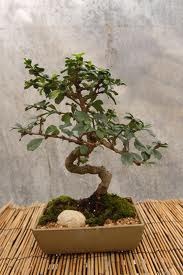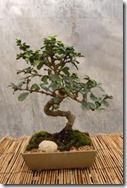Japanese bonsai artists have developed many intricate and detailed forms of bonsai trees, in which each element is positioned just so. This is evident in the shakan, or slanting, style.
As the name suggests, the trunk of the bonsai trees is slanted, usually at a moderately steep angle, mid-way between an upright and a cascade style. The slant will be anywhere from 30 degrees to as much as 75 degrees. The lowest branch is made to point away from the direction of the trunk, lending a visual balance important to the bonsai artist.
Full-sized trees in nature acquire these characteristics as the result of early development in an environment where wind has a tendency to blow more in one direction than another. Another key factor is the amount of shade present above the young tree. Contributing to the effect is gravity acting on a trunk weaker in one direction than another. The shape of the ground holding the tree and the location and amount of water also influence the outcome, though to a lesser degree.
All these factors can be emulated in bonsai trees. As with any bonsai training, it’s best to start with a species or instance that is amenable to the style. Luckily for the artist, many bonsai trees will experience a natural slant to some degree. Bringing this out to a more pronounced state is simply a matter of training and patience.
The trunk, though slanted, will be straight rather than curved. Of course, as with all artistry involving bonsai trees, within this apparently rigid classification there is much variation. Bonsai, though a disciplined art, always finds room for the artist’s individual interpretation.
Even so, care should be taken to keep the result in balance. Longer branches should be distributed away from the slant, shorter branches in the same direction. Longer roots should be encouraged away from the slant, again so the bonsai tree has pleasing balance.
Within the style there are several sub-types, such as dai-shakan and chu-shakan. Each sub-type refers to the direction in which the branches are trained relative to the angle of the trunk. In the chu-shakan style, for example, the branch is trained back toward the trunk. Dai-shakan, by contrast, spreads the branches away from the trunk of the bonsai tree.
Conifers, such as White Pine, make good ‘modeling clay’ for this style of indoor bonsai trees. In order to display them to best advantage, they should be planted in the center of a rectangular pot.


Deprecated: strpos(): Passing null to parameter #1 ($haystack) of type string is deprecated in /home/agriviek8Qv/agriviet.net/public_html/wp-includes/comment-template.php on line 2522